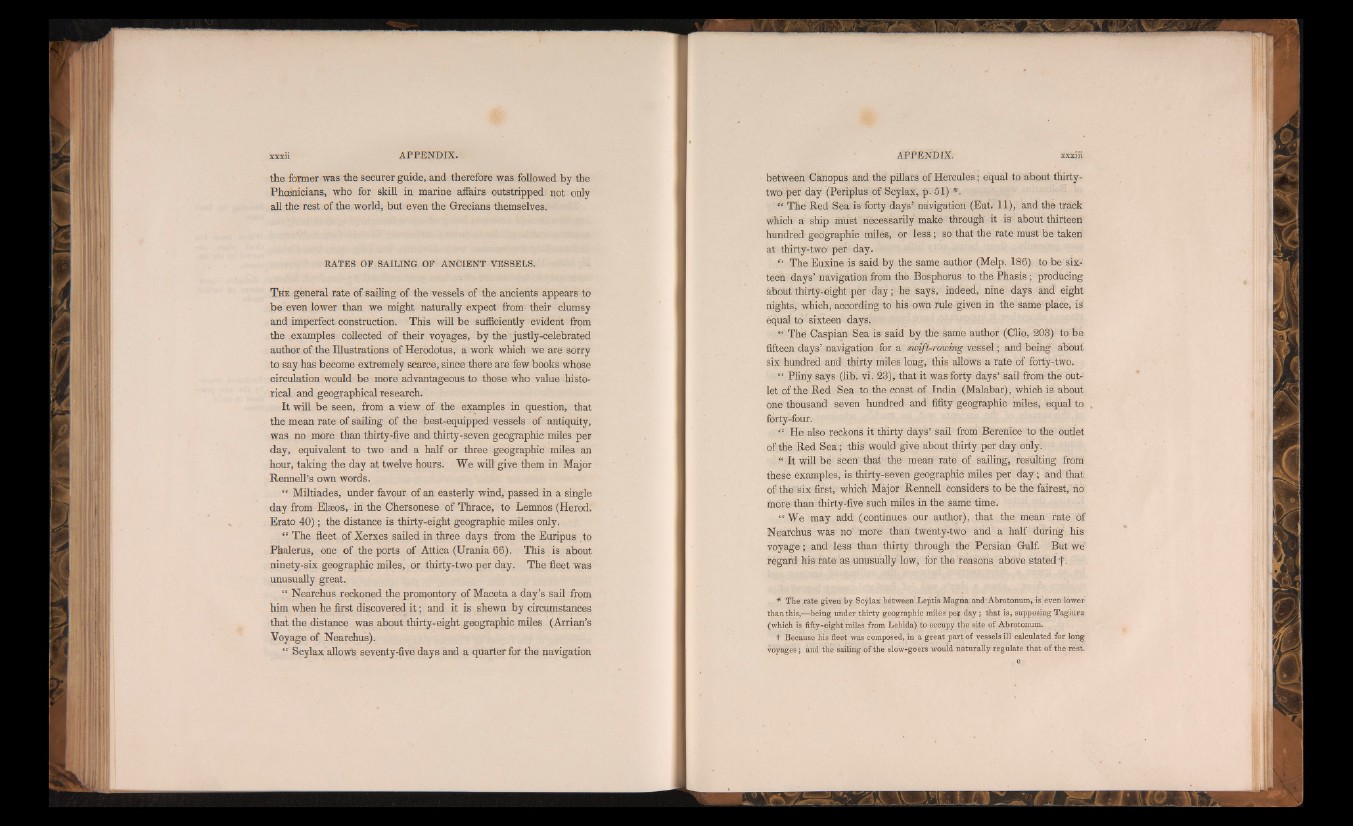
th e former was the securer guide, and therefore was followed by the
Phoenicians, who for skill in marine affairs outstripped not only
all the rest of th e world, but even the Grecians themselves.
RATES OF SAILING OF ANCIENT VESSELS.
T h e general rate of sailing of the vessels of the ancients appears to
b e even lower than we might naturally expect from their clumsy
and imperfect construction. This will b e sufficiently evident from
the examples collected of their voyages, by the justly-celebrated
author of the Illustrations of Herodotus, a work which we are sorry
to say has become extremely scarce, since there are few books whose
circulation would b e more advantageous to those who value historical
and geographical research.
I t will b e seen,, from a view of the examples in question, that
the mean rate of sailing of the best-equipped vessels of antiquity,
was no more than thirty-five and thirty-seven geographic miles per
day, equivalent to two and a half or three geographic miles an
hour, taking the day a t twelve hours. We will give them in Major
Rennell’s own words.
“ Miltiades, under favour of an easterly wind, passed in a single
d ay from Elaeos, in the Chersonese of Thrace, to Lemnos (Herod.
Erato 40) ; the distance is thirty-eight geographic miles only.
“ The fleet of X erxes sailed in three days from the Euripus to
Phalerus, one of the ports of Attica (Urania 66). This is about
ninety-six geographic miles, or thirty-two p e r day. T h e fleet was
unusually great.
“ Nearchus reckoned the promontory of M aceta a d ay ’s sail from
him when he first discovered i t ; and it is shewn by circumstances
th a t th e distance was about thirty-eight geographic miles (Arrian’s
Voyage of Nearchus).
“ Scylax allows seventy-five days and a quarter for the navigation
between Canopus and the pillars of Hercules; equal to about thirty-
two per day (Periplus of Scylax, p. 51) *.
“ The’ Red Sea i s forty days’ navigation (Eut. 11), and the track
which a ship must necessarily make through it is about thirteen
hundred geographic miles, or le s s ; so that the rate must be taken
at thirty-two' per day.
“ The Euxine is said by the same author (Melp. 186) to be sixteen
days’ navigation from the Bosphorus to the Phasis ; producing
about thirty-eight per d a y ; he says, indeed, nine days and eight
nights, which, according to his own rule given in the same place, is
equal to sixteen days.
“ The Caspian Sea is said by the same author (Clio, 203) to be
fifteen days’ navigation for a swift-rowing v e sse l; and being about
six hundred and thirty miles long, this allows a rate of forty-two.
Pliny says (lib. vi. 23), that it was forty days’ sail from the outlet
of the Red Sea to the coast of India (Malabar), which is about
One thousand seven hundred and fifity geographic miles, equal to
forty-four.
“ He also reckons it thirty day s’ sail from Berenice to the outlet
of the Red S e a ; this would give about thirty per day only.,
. “ I t will b e seen that the mean rate of sailing, resulting froni
these examples, is thirty-seven geographic miles per d a y ; and that
of the six first, which Major Rennell considers to be the fairest, no
more than thirty-five such miles in the same time.
“ We may add (continues our author), that the mean rate of
Nearchus was no' more' than twenty-two and a half during his
v o y ag e ; and less than thirty through the P ersian Gulf. But we
regard his ra te as unusually low, for the reasons above stated f .
* The rate given by Scylax between Leptis Magna and Abrotonum, is even lower
than this,—being under thirty geographic miles per day; that is, supposing Tagiura
(which is fifty-eight miles from Lebida) to occupy the site of Abrotonum.
t Because his fleet was composed, in a great part of vessels ill calculated for long
voyages ; and the sailing of the slow-goers would naturally regulate that of the rest.